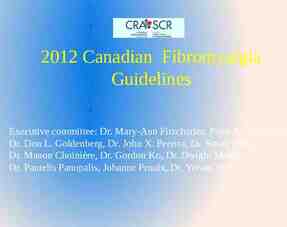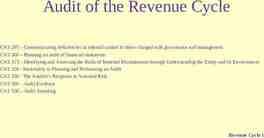Introduction to flow cytometry Dr Aris Chaidos MD PhD Consultant
30 Slides6.86 MB

Introduction to flow cytometry Dr Aris Chaidos MD PhD Consultant Haematologist (Locum) BSc Haematology Introduction Module 2012 [email protected]

Flow Cytometry A fascinating technology for the study of cells or other particles Qualitative & Quantitative data Multiparametric analysis Analysis of large number of cells Many applications in haematology and immunology

Historical aspects Light microscopy: cell-to-cell analysis Fluorescence microscopy: study of phenotypes

How it was made possible: the monoclonal antibodies (Mabs) MAbs recognise a single antigen epitope Kohler, Milstein and Jerne, Nobel Prize (1984)

Cluster of Differentiation (CD) nomenclature

How it was made possible: the fluorochromes LASER 488nm Molecules that can absorb a LASER light (excitation) and release emitted light at different wavelengths (emission spectrum) Fluorochrome-conjugated monoclonal Abs recognise different cell protein-targets LASER 407nm

The Flow Cytometer: what is in the box Flucidics Computer a system of lines directs the fluid stream and centres the cells to the light beam Data harnessing and analysis Electronics LASER beams Optics Light filters, mirrors and optic fibres Light detectors Signal processing

The Flow Cytometer: making signal from cells

material for analysis single cell suspension (WBC, RBC, PLT etc) peripheral blood Cells (50-100µl) MAbs bone marrow aspirate Other body fluids solid tissues! (ascites, CSF, (lymph nodes) pleural etc) Sample processing Incubation 20min wash of Mabs excess in buffer acquisition in the flow cytometer

data presentation and analysis normal peripheral blood Dot plots neutrophils monocytes debris lymphocytes Contour plots pseudocolour

data presentation and analysis gating SSC sideways scatter FSC forwards scatter histograms

data presentation and analysis gating

data presentation and analysis overlay staining intensity: Median Fluorescence Intensity (MFI) MFI 1679 monocytes T cells monocytes MFI 9177 T cells

data presentation and analysis Intracellular antigen flow cytometry: the example of T regulatory cells CD3 CD4 CD8 CD3 (T cells) CD3 Tregs CD25 CD3 CD4 CD25 highFoxP3 FoxP3 (intracellular) CD4

Applications in Clinical Haematology Diagnosis & classification of leukaemias and lymphomas Detection of minimal residual disease Measurement of the absolute CD4 T cells number Measurement of CD34 cells in bone marrow grafts Assessment of lymphocyte clonality: kappa / lambda or TCR Diagnosis of paroxysmal nocturnal haemoglobinuria (PNH) Feto-maternal haemorrhage Diagnosis of platelet disorders

Phenotyping normal vs malignancy normal leukaemia/lymphoma Normal physical characteristics (FSC/SSC) Abnormal FSC/SSC pattern, predominant population Normal blood cells gain or lose antigen expression during differentiation stages Immature phenotypes in great number in the periphery or marrow Lineage specific markers Aberrant markers (lineage infidelity) Normal patterns of antigen expression Polyclonal (B cells / or T cells TCRαβ) Aberrant combinations of CD antigens Monoclonal

Acute myeloid leukaemia classification, prognosis, minimal residual disease Low SSC: hypogranularity Non-lineage specific markers CD34 (stem cells) CD45 (most leukocytes) HLA-DR Myeloid markers Myeloperoxidase (MPO) CD33 CD117 (c-kit receptor) CD13 Aberrant expression CD2 CD7 CD56 Erythroid Glycophorin A Megakaryocytic CD41/CD61

Acute myeloid leukaemia Some expression patterns may indicate certain genetic abnormalities AML t(8;21)(q22;q22) CD19 and CD79b (B cell markers) AML inv(16) or t(16;16) Strong expression CD34 & CD117 Frequent CD2 (T/NK cell marker)

Acute promyelocytic leukaemia t(15;17)(q22;q12);PML-RARA CD34- HLADR- MPO CD33 CD13

Acute lymphoblastic leukaemia classification, prognosis, minimal residual disease B-ALL CD34 CD19 cytoplasmic CD79b cytoplasmic CD22 Terminal deoxynucleotidyl transferase (TdT) CD10 T-ALL CD34 TdT CD1a CD2 CD3 CD5

Acute lymphoblastic leukaemia classification, prognosis, minimal residual disease

Chronic lymphocytic leukaemia (CLL) normal CLL CLL score sIgM/IgD: weak CD5: CD23: CD79b/CD22: weak/ FMC7: - B cells T cells CD5 CD19 CD19 B cells CLL T cells CD5

Clonality of B lymphocytes normal leukocytes B cells cytoplasmic kappa polyclonal 58% 42% cytoplasmic lambda kappa light chain restriction Plasma cells cytoplasmic kappa MGUS marrow 94% 6% cytoplasmic lambda

MRD: minimal residual disease Detection of residual myeloma cells post treatment normal plasma cells Plasma cells myeloma marrow 0.4% 19% CD19 CD138 myeloma plasma cells CD38 81% CD56

Diagnosis of Red Cell disorders Paroxysmal Nocturnal Haemoglobinuria (PNH) Rare disease, acquired mutation of PIG-A gene in stem cells Unable to produce glycosylphospatidylinositol (GPI) Loss of expression of several surface molecules e.g. CD59 control normal PNH RBC PNH clone PLT

Diagnosis of Red Cell disorders Feto-maternal haemorrhage Detection of fetal RBC using anti-HbF Source: Trillium Diagnostics, LLC

Diagnosis of platelet disorders Inheriting glycoprotein deficiencies & functional assays Investigate or confirm diagnosis of Glanzmann thrombasthenia: defect of Gp IIb/IIIa (CD41/CD61) Bernard-Soulier syndrome: defect of Gp Ib (CD42b) Scott syndrome (defect of phosphatidylserine translocation) Diagnosis of platelet storage pool diseases Monitoring of GpIIb/IIIa antagonist therapy

Diagnosis of platelet disorders Glanzmann thrombasthenia normal Glanzmann thrombasthenia Source: Practical-Hemostasis.com

Diagnosis of platelet disorders Bernard-Soulier syndrome transfused platelets CD42bplatelets Source: Practical-Hemostasis.com

Summary Flow cytometry is a powerful technology for the phenotypic and functional, multi-parameter analysis of large number of cells Many clinical application in haematology Diagnosis, classification and follow-up of leukaemias/lymphomas Minimal residual disease Transfusion and stem cell transplantation Haemostasis Immunophenotyping is essential component of the modern haematology diagnostics, along with morphology, cytogenetics and molecular diagnostics






